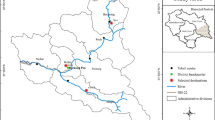Abstract
Tourism development has a unique responsibility in regional policy of almost all countries. It is a well known fact that tourism has a remarkable contribution in sustainable development, economic growth and social benefits for a country, if planned methodically. This is due to its unquestionable advantages and benefits for the local community with respect to economic, social and environmental aspects. Since few decades, it has become a driving area in Indian economic planning strategy to deal with tourism issues for effective utilization of its wide range of destination resources and also optimize the intensity of financial involvement for developing tourist infrastructure in a restraint economic province. This paper applies a simple methodology to quantify the tourism potential of Indian states using an integrated visual decision aid model of preference ranking organization method for enrichment evaluation (PROMETHEE) and geometrical analysis for interactive aid (GAIA). Several social and physical attributes are considered to evaluate and rank the Indian states with respect to their performance in tourism. The adoption of this integrated visual decision aid model identifies Jammu and Kashmir, and Jharkhand as the best and the worst performing states respectively. In GAIA plane, the position of Jammu and Kashmir is the farthest from origin, followed by Madhya Pradesh. A close comparison between these two top performing states reveals that Jammu and Kashmir mainly outperforms Madhya Pradesh with respect to budget allocation, population density, pollution index and cost of living index criteria. The performance of Jharkhand is not at all the best with respect to even a single criterion. In GAIA plane, it is also observed that the considered beneficial and non-beneficial criteria form two different clusters, as expected. This performance evaluation problem is identified to be not at all a hard problem to solve.









Similar content being viewed by others
References
Ali, N.H., Sabri, I.A.A., Noor, N.M.M., Ismail, F.: Rating and ranking criteria for selected Islands using fuzzy analytic hierarchy process (FAHP). Int. J. Appl. Math. Inform. 6(1), 57–65 (2012)
Ardakani, M.K.: Ranking different factors influencing on development of tourism industry. Manag. Sci. Lett. 4(5), 917–920 (2014)
Ashouri, P., Fariyadi, S.: Potential assessment of nature-based tourism destinations using MCA techniques (case study: Lavasan-e Koochak). J. Environ. Stud. 36(55), 1–3 (2010)
Brans, J.P., Vincke, P.: A preference ranking organization method: The PROMETHEE method for MCDM. Manag. Sci. 31(6), 647–656 (1985)
Brans, J.P., Vincke, P., Mareschal, B.: How to select and how to rank project: The PROMETHEE method. Eur. J. Oper. Res. 24(2), 228–238 (1986)
Brans, J.P., Mareschal, B.: The PROMCALC and GAIA decision-support system for multi criteria decision aid. Decis. Support. Syst. 12(4–5), 297–310 (1994)
Enright, M.J., Newton, J.: Tourism destination competitiveness: A quantitative approach. Tour. Manag. 25(6), 777–788 (2004)
Formica, S.: Destination Attractiveness as a Function of Supply and Demand Interaction. Doctoral Dissertation, Virginia Polytechnic Institute and State University, Virginia, USA (2000)
Forsyth, P., Dwyer, L.: Tourism price competitiveness. In: Blanke, J., Chiesa, T. (eds.) The Travel and Tourism Competitiveness Report 2009, pp. 77–90. World Economic Forum, Geneva (2009)
Gooroochurn, N., Sugiyarto, G.: Competitiveness indicators in the travel and tourism industry. Tour. Econ. 11(1), 25–43 (2004)
Hsu, T.-K., Tsai, Y.-F., Wu, H.-H.: The preference analysis for tourist choice of destination: a case study of Taiwan. Tour. Manag. 30(2), 288–297 (2009)
http://www.imf.org/external/pubs/ft/weo/2013/02/weodata/index.aspx, World Economic Outlook Database, International Monetary Fund
Kozak, M., Rimmington, M.: Measuring tourist destination competitiveness: conceptual considerations and empirical findings. Hosp. Manag. 18(3), 273–283 (1999)
Liu, C.-H., Tzeng, G.-H., Lee, M.-H.: Improving tourism policy implementation: the use of hybrid MCDM models. Tour. Manag. 33(2), 413–426 (2012)
Melián-González, A., García-Falcón, J.-M.: Competitive potential of tourism in destinations. Ann. Tour. Res. 30(3), 720–740 (2003)
Michailidis, A., Chatzitheodoridis, F.: Scenarios analysis of tourism destinations. J. Soc. Sci. 2(2), 41–47 (2006)
Mohamad, D., Jamil, R.-M.: A preference analysis model for selecting tourist destinations based on motivational factors: A case study in Kedah, Malaysia. Procedia - Soc. Behav. Sci. 65(3), 20–25 (2012)
Rao, R.V.: Decision Making in the Manufacturing Environment using Graph Theory and Fuzzy Multi Attribute Decision Making Methods. Springer, London (2007)
Riza, P., Asokan, R.: A comparative study of tourism industry in north-eastern states of India. IOSR J. Bus. Manag. 12(4), 56–62 (2013)
Rodenburg, E.E.: The effects of scale in economic development: Tourism in Bali. Ann. Tour. Res. 7(2), 177–196 (1980)
Sharma, K.K.: Tourism and Regional Development. Sarup & Sons, New Delhi (2004)
Singh, N., Ahuja, S., Nedelea, A.: Comparative analysis between centralized and state-wise tourism campaigns in India. J. Tour. 13(1), 14–20 (2011)
Uma Devi, R.: An evaluative study of tourism industry in Puducherry, U.T. of India. Int. J. Innov. Res. Dev. 2(6), 80–103 (2013)
Wu, W.-W.: Beyond travel and tourism competitiveness ranking using DEA, GST. ANN and Borda count. Expert Syst. Appl. 38(10), 12974–12982 (2011)
Zhang, H., Gu, C.-L., Gu, L.-W., Zhang, Y.: The evaluation of tourism destination competitiveness by TOPSIS and information entropy: A case in the Yangtze River Delta of China. Tour. Manag. 32(2), 443–451 (2011)
Zhou, Y., Maumbe, K., Deng, J., Selin, S.W.: Resource-based destination competitiveness evaluation using a hybrid analytic hierarchy process (AHP): The case study of West Virginia. Tour. Manag. Perspect. 15, 72–80 (2015)
Author information
Authors and Affiliations
Corresponding author
Rights and permissions
About this article
Cite this article
Ranjan, R., Chatterjee, P. & Chakraborty, S. Performance evaluation of Indian states in tourism using an integrated PROMETHEE-GAIA approach. OPSEARCH 53, 63–84 (2016). https://doi.org/10.1007/s12597-015-0225-6
Accepted:
Published:
Issue Date:
DOI: https://doi.org/10.1007/s12597-015-0225-6




